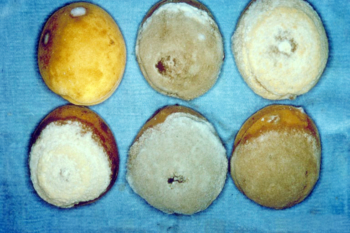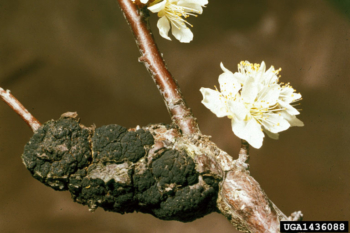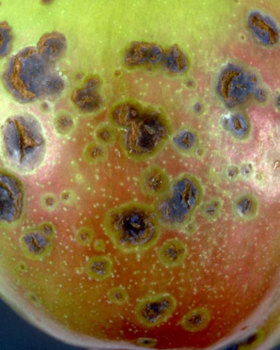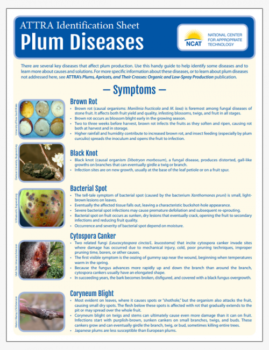ATTRA Identification Sheet: Plum Diseases
By Guy K. Ames, NCAT Agriculture Specialist
There are several key diseases that affect plum production. Use this handy guide to help identify some diseases and to learn more about causes and solutions.
Symptoms
Brown Rot

Brown rot on plums. Photo: University of New South Wales
Brown rot (causal organisms: Monilinia fructicola and M. laxa) is foremost among fungal diseases of stone fruit. It affects both fruit yield and quality, infesting blossoms, twigs, and fruit in all stages.
Brown rot occurs as blossom blight early in the growing season.
Two to three weeks before harvest, brown rot infects the fruits as they soften and ripen, causing rot both at harvest and in storage.
Higher rainfall and humidity contribute to increased brown rot, and insect feeding (especially by plum curculio) spreads the inoculum and opens the fruit to infection.

Black knot on plum. Photo: Clemson University, Bugwood.org
Black Knot
Black knot (causal organism Dibotryon morbosum), a fungal disease, produces distorted, gall-like growths on branches that can eventually girdle a twig or branch.
Infection sites are on new growth, usually at the base of the leaf petiole or on a fruit spur.
Bacterial Spot
The tell-tale symptom of bacterial spot (caused by the bacterium Xanthomonas pruni) is small light-brown lesions on leaves.

Bacterial spot on plum. U. Mazzucchi, Bugwood.org
Eventually the affected tissue falls out, leaving a characteristic buckshot-hole appearance.
Severe bacterial spot infections may cause premature defoliation and subsequent re-sprouting.
Bacterial spot on fruit occurs as sunken, dry lesions that eventually crack, opening the fruit to secondary infections and reducing fruit quality.
Occurrence and severity of bacterial spot depend on moisture.

Cytospora Canker. Photo: Utah State University Extension
Cytospora Canker
Two related fungi (Leucocytospora cincta/L. leucostoma) that incite cytospora canker invade sites where damage has occurred due to mechanical injury, cold, poor pruning techniques, improper pruning time, borers, or other causes.
The first visible symptom is the oozing of gummy sap near the wound, beginning when temperatures warm in the spring.
Because the fungus advances more rapidly up and down the branch than around the branch, cytospora cankers usually have an elongated shape.
In succeeding years, the bark becomes broken, disfigured, and covered with a black fungus overgrowth.

Coryneum blight. Photo: Marion Murray, USU Extension
Coryneum Blight
Most evident on leaves, where it causes spots or “shothole,” but the organism also attacks the fruit, causing small dry spots. The flesh below these spots is affected with rot that gradually extends to the pit or may spread over the whole fruit.
Coryneum blight on twigs and stems can ultimately cause even more damage than it can on fruit. Infections start with purplish-brown, sunken cankers on small branches, twigs, and buds. These cankers grow and can eventually girdle the branch, twig, or bud, sometimes killing entire trees.
Japanese plums are less susceptible than European plums.
Key Low-Spray and Organic Solutions
Brown Rot
Cultural practices and orchard sanitation are the first lines of defense. Planting-site selection and pruning are critical to providing sufficient air circulation and sunlight penetration within the canopy. Keep the orchard some distance from surrounding woods so that air movement is not blocked or slowed by the presence of surrounding trees and the plum curculio does not have access to overwintering habitat. Recommended orchard sanitation practices include pruning out and removing infected twigs and cankers and disposing of dropped, culled, or mummified fruit. Organic growers have traditionally relied on sulfur or sulfur-containing fungicides to control brown rot. Apply wettable sulfur every 10 to 14 days from petal fall until harvest. Spray more often during wet seasons. Augmenting sulfur with Surround™ WP Crop Protectant provides better control, but may leave problematic residue on the fruit. The biofungicide, Serenade™ (Bacillus subtilis, QST 713 strain) is OMRI approved and has demonstrated laboratory and field control of brown rot in California, but has been less effective in other regions and climates.
Black Knot
Trees should be checked several times throughout the season, and the knots pruned out by making cuts three to four inches below the knot. Pruners should be sterilized between cuts. A single lime-sulfur spray before budswell will reduce black knot problems. There is some resistance among plum varieties. In general, Japanese plum types are less susceptible than the European types.
Bacterial Spot
Selecting disease-resistant cultivars is the principal means of controlling bacterial spot. Copper fungicides—unique in that they also function as bactericides—are allowed in organic production for control of bacterial spot. The first spray should be applied before the tree leafs out in the spring. The next period when infection pressure is heavy is petal fall and three weeks thereafter. Additional spray coverage may be necessary depending on varietal susceptibility and humid weather conditions.
Cytospora Canker
The disease progresses slowly, and a tree with cytospora can survive for many years past the initial infection. Management begins by choosing planting sites away from older peach and plum trees and by eliminating wild or untended plums and peaches near the orchard. Because cold damage is often the primary infection site, painting trunks with whitewash to reflect the winter sun can be helpful. Other management techniques center around minimizing damage to the trees by pruning only in the early spring when temperatures have warmed, avoiding leaving pruning stubs, removing dead and diseased branches, and controlling borers.
Coryneum Blight
Remove and destroy all infected twigs and branches as you see them. Spray your tree with a fungicide (OMRI-approved copper or lime-sulfur sprays work) just as the buds begin to swell in the spring. Spray the tree again as soon as the petals begin to drop. In a wet year or location, sprays may have to continue every two weeks until symptoms subside or the weather turns dry.
ATTRA Identification Sheet: Plum Diseases
By Guy K. Ames, NCAT Agriculture Specialist
Published November 2014
©NCAT
IP485, slot 497
This publication is produced by the National Center for Appropriate Technology through the ATTRA Sustainable Agriculture program, under a cooperative agreement with USDA Rural Development. ATTRA.NCAT.ORG.


